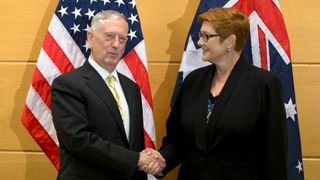The outcome of the recent AUSMIN meeting—the annual gathering of the secretaries of state and defence from the United States and the foreign and defence ministers from Australia—was a signal of the alliance’s increasing focus on the Indo-Pacific region.
The joint statement stemming from the meeting announced the creation of a ‘joint work plan’ that would focus future efforts on the Indo-Pacific, touching on diplomatic, security and geoeconomic activities throughout the region. On the defence collaboration front, a new agreement was signed to jointly develop, research and test new cyber capabilities. Hypersonics were singled out as an area where cooperation between the two countries should be strengthened, particularly on concept development, testing and ‘validation’ of high-speed flight technologies.
This was a welcome shift in direction. But considering the location of the meeting—Stanford University, in the heart of Silicon Valley—it was a missed opportunity to drive an ambitious agenda for how the alliance can invest in joint defence technology projects and use private sector innovation to address shared national security challenges.
Since the Cold War, traditional defence companies and national laboratories have lost the monopoly they once had on developing the cutting-edge technologies that will be central to future military advantage. In select areas, research and development funding has also shifted from the government to the private sector. Innovative major companies and even start-ups are making advances in fields important to national defence, such as machine learning and quantum technology.
Harnessing these advances is critical for the future of the alliance. Despite growing defence budgets, Australia and the US can’t spend their way out of the mounting security challenges in the Indo-Pacific—ranging from an increasingly assertive and militarily capable China, to a still nuclear-armed North Korea and resilient terrorist networks in Southeast Asia. Harvesting technologies from the commercial sector can help offset the cost of new defence capabilities while addressing some of these shared challenges.
Focusing on ways Australia and the United States can work together on new defence technologies is also a practical and useful undertaking. With the White House’s approach to longstanding allies less predictable under President Donald Trump, it is increasingly important for countries like Australia to build new connections with the commercial sector in the US and across the American defence establishment.
Then there’s China, the primary challenger to the rules-based order in the Indo-Pacific. Beijing is actively pursuing what it calls ‘civil–military fusion’—or the leveraging of its corporate science and technology sector for advances in military capability. And it is succeeding: Chinese researchers recently set a new world record for quantum entanglement (an essential aspect of quantum cryptography), and the PLA is quickly forging closer links with both the private sector and universities.
To be sure, Australia and the United States are not standing still.
In early 2017, the Australian Defence Department established the Defence Innovation Huband the Next Generation Technology Fund. Both focus on providing resources and promoting private sector engagement on national security issues. Despite being slow to start, the Defence Innovation Hub has begun to announce grants to Australian companies, including a $1.2 million contract to space engineering firm Sabre Astronautics.
The US established its own defence innovation unit in 2015. The Defense Innovation Unit Experimental (DIUx) has enabled the Pentagon to partner with start-ups in Silicon Valley and beyond that are developing technologies relevant to concrete military operational problems.
Yet these individual efforts haven’t yet translated into a concrete program of alliance collaboration.
Following on from this year’s AUSMIN, Canberra and Washington should start by picking off some low-hanging fruit. Modest steps, like an exchange of personnel between Australia’s Defence Innovation Hub and America’s DIUx, would create momentum and pave the way for future cooperation.
More extensive and high-impact collaborations will take time to realise. The two governments could evaluate the feasibility of establishing a platform for Australian and American entrepreneurs to come together to launch companies focused on specific national security themes. Australia and the US should also begin to map where each country possesses comparative advantages or pockets of technological excellence.
In an era of great-power competition, where gaining and maintaining technological advantage will be a defining feature, leveraging commercial innovation for defence must become a central element of the alliance. The time to start is now.






